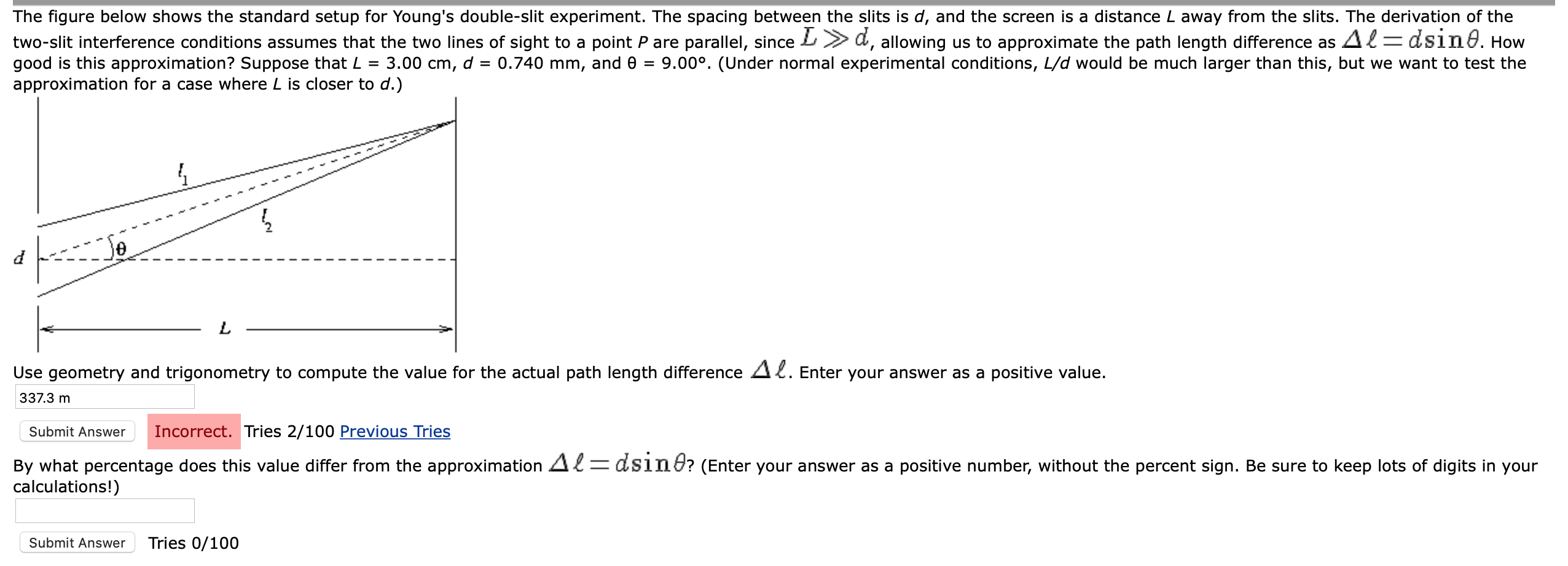Question

Transcribed Image Text:The figure below shows the standard setup for Young's double-slit experiment. The spacing between the slits is d, and the screen is a distance L away from the slits. The derivation of the
two-slit interference conditions assumes that the two lines of sight to a point P are parallel, since L>d, allowing us to approximate the path length difference as 42= dsıne. How
3.00 cm, d = 0.740 mm, and 0 =
good is this approximation? Suppose that L =
approximation for a case where L is closer to d.)
9.00°. (Under normal experimental conditions, L/d would be much larger than this, but we want to test the
Use geometry and trigonometry to compute the value for the actual path length difference A2. Enter your answer as a positive value.
337.3 m
Incorrect. Tries 2/100 Previous Tries
Submit Answer
By what percentage does this value differ from the approximation Al=dsint? (Enter your answer as a positive number, without the percent sign. Be sure to keep lots of digits in your
calculations!)
Submit Answer
Tries 0/100
Expert Solution
This question has been solved!
Explore an expertly crafted, step-by-step solution for a thorough understanding of key concepts.
This is a popular solution
Trending nowThis is a popular solution!
Step by stepSolved in 5 steps with 5 images

Knowledge Booster
Similar questions
- In a double-slit interference experiment, d is the distance between the centers of the slits and w is the width of each slit, as shown in the figure above. For incident plane waves, if an interference maximum on a distant screen will fall at a diffractive minimum, which of the following relations between d and w is correct? @ 3d=2w @ 2d=3w. @d=3¹/2w. @d=2¹/2w @ 2d=w.arrow_forwardIn Young’s double slit experiment, the two slits 0.12 mm apart are illuminated by monochromatic light of wavelength 420 nm. The screeen is 1.0 m away from the slits. (a) Find the distance of the second (i) bright fringe, (ii) dark fringe from the central maximum. (b) How will the fringe pattern change if the screen is moved away from the slits?arrow_forwardIn an interference experiment using a monochromatic source emitting light of wavelength 1, the fringes are produced by two long, narrow slits separated by a distance d. The fringes are formed on a screen which is situated at a distance D >> d.Write down an expression for the fringe width w. Please use "*" for products (e.g. B*A), "/" for ratios (e.g. B/A) and the usual "+" and "-" signs as appropriate. Use "lambda" (without the quotes) for 1 in the equation box. For example, use d*lambda for d2. Please use the "Display response" button to check you entered the answer you expect. w=arrow_forward
- why is this solution wrong for finding one specific dark spot or minimum and why answer is smaller that thisarrow_forwardThe analysis of any two-point source interference pattern and a successful determination of wavelength demands an ability to sort through the measured information and equating the values with the symbols in Young's equation. Apply your understanding by interpreting the following statements and identifying the values of y, d, m and L. Finally, perform some conversions of the given information such that all information share the same unit. Two slits that are 0.200 mm apart produce an interference pattern on a screen such that the central maximum and the 10th bright band are distanced by an amount equal to one-tenth the distance from the slits to the screen. y= ________ d=________ m=_______ L=________arrow_forwardWrite down an expression for the highest order mof diffraction in a double slit experiment if the distance between the slits is a and slits are illuminated with light of the wavelength . Please use "*" (without the quotes) for products (e.g. B*A), "/" for ratios (e.g. B/A) and the usual "+" and "- "signs as appropriate. For exponents (e.g. A²) use A*A or A^2 notation: thus A³/B should appear as either A*A*A/B or A^3/B. For greek letters use "theta" (without the quotes) and for trigonometric functions use "cos", "tan", "sin" (without the quotes). Thus for Acose use A*cos theta. Please use the "Display response" button to check you entered the answer you expect. Answer: Display responsearrow_forward
- In a Young's double slit experiment the two slits are 0.037 mm apart and the screen is 2.48 m away from the slits. If the wavelength of the light used is 643 order bright fringe be located (in cm)? then how far away from the central bright fringe will the third nm,arrow_forwardSuppose the separation of the narrow slits in Young's Experiment is 1.000 mm and the viewing screen is 5.000 m away. Plane waves of monochromatic 589.3-nm light illuminate the slits and the whole setup is in air where n = 1.00029. What would happen to the fringe separation if all the air was pumped out?arrow_forwardWhen performing Young's.double slit experiment, at what angle (in degrees) is the first-order maximum for 577 nm wavelength light falling on double slits if the separation distance is 0.0560 mm? Your Answer:arrow_forward
arrow_back_ios
arrow_forward_ios